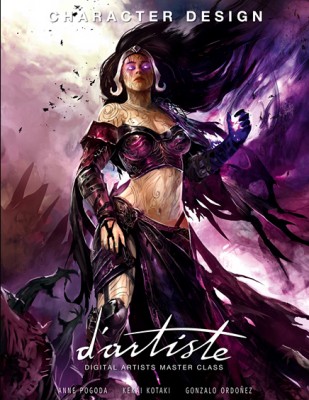Book review: d’artiste: Character Design
 Focus is the key to success in the latest of Ballistic Publishing’s series of digital art tutorial books, says Fernando Caire
Focus is the key to success in the latest of Ballistic Publishing’s series of digital art tutorial books, says Fernando Caire
With several different ranges of art instruction books, each one updated regularly, Ballistic Publishing is in a class of its own. New this month is the ninth in its d’artiste series, Character Design: a collection of tutorials by industry professionals Anne Pogoda, Kekei Kotaki and Gonzalo Ordoñez. To anyone who has bought a Ballistic book before, the pedigree will not be in doubt – but with so many predecessors, does this new book have enough fresh material to justify a purchase?
In a word: yes. Unlike many instructional titles, whose subject matter is all over the place, this one covers a broad range of techniques but focuses on only one subject. Whereas many books flit from 3D modelling to matte painting and illustration, making it difficult to know which one to pull out to look up a specific subject, if I ever need to reference a technique in character design, this will be the first one I will grab.
Each artist brings their own unique style to their tutorials. Anne Pogoda focuses on realistic portraits of women, whereas Kekai Kotaki’s experience working on Guild Wars 2 provides a more games-centric approach to designing characters. Lastly, Gonzalo Ordoñez brings some more illustrative, Japanese-inspired techniques to the table. The diversity of the instruction on offer is complemented by the attractive galleries of each artist’s work.
Strength through diversity
Anne Pogoda explains how to design a female character in different variations (rebel, cute girl, and sci-fi girl – who, oddly enough, looks like Quorra from Tron Legacy), how a paint in an anime style, and how to combine two paintings. The section on creating variant designs is informative, but the final pieces do look like a bit rushed. The cute girl is the best, and most detailed, piece from this section; the others feel thrown together. (Pogoda uses a Photoshop default brush to create the star tattoos on the ‘rebel’ design, for example). The next two sections will not disappoint, though, displaying a great use of color, gesture and methods of problem solving.
Kekai Kotaki’s tutorials are pretty straightforward, showing how to digitally paint three different types of characters. Pinning down the traits of a wild, a heroic and an evil character may seem easy, but Kotaki’s execution is masterly, proving that the task is more difficult then you might think. He paints directly into Photoshop without using line drawings, instead blocking in shapes and colors. His design process allows him to improvise different gestures and poses until he finds one that will work for the final piece.
Last, but certainly not least, is Gonzalo Ordoñez, who brings a more illustrative touch to the book. His use of saturated color makes his designs really pop, not to mention the bold anime-like style he uses. Unlike the other two artists, he only provides two tutorials, but since they are much larger in scale, it’s hard to complain. Seeing Ordoñez’s work, which is filled to the brim with detail, could feel a little daunting, but his tutorials show that no matter how detailed and crisp a final piece is, all you need is the patience to get there, one step at a time.
A model for other publishers
With both paperback and limited-edition hardcover editions available, there should be a version of the book to suit most budgets. (Athough admittedly, the hardcover will set you back $170.) d’artiste: Character Design is a very high-quality product, and one that will benefit any artist, whether novice or professional. I only wish that there were more art books that focused on a single subject, but covered so many different styles and techniques.
Read full details and view previews of the tutorials on the Ballistic Publishing website
